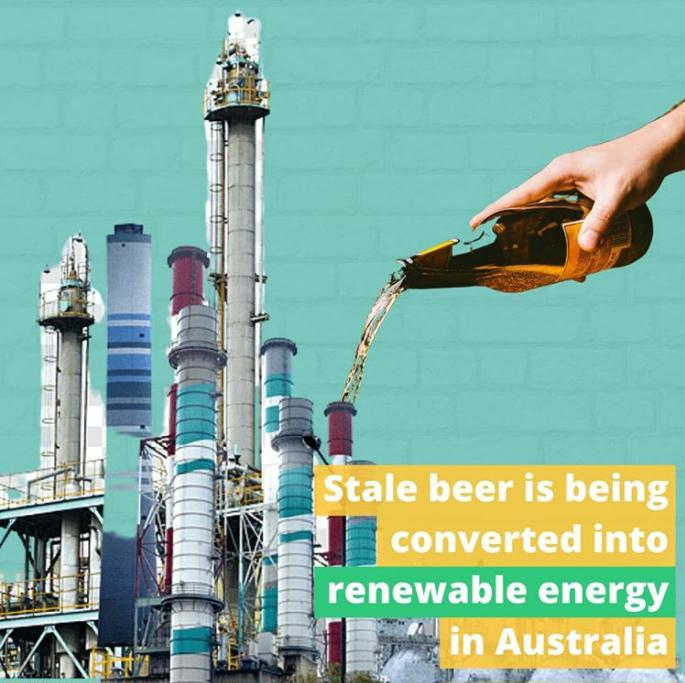
Preface. Unfortunately, turning beer into biogas requires a pandemic so that it isn’t drunk at pubs instead. Scientists assure us there will be more pandemics as we mow down (rain)forests for shopping malls and come into contact with new viruses, so fair warning, buy the beer before it turns into biogas…
Alice Friedemann www.energyskeptic.com author of “When Trucks Stop Running: Energy and the Future of Transportation”, 2015, Springer, Barriers to Making Algal Biofuels, and “Crunch! Whole Grain Artisan Chips and Crackers”. Podcasts: Collapse Chronicles, Derrick Jensen, Practical Prepping, KunstlerCast 253, KunstlerCast278, Peak Prosperity , XX2 report
* * *
2020. ‘Liquid Gold’: Stale beer turned into renewable energy in Australia. Euronews.
Millions of litres of beer have been lying stale in Australia’s pubs and clubs amid the coronavirus pandemic. But, rather than let it all go to waste, the expired beer is being converted into renewable energy to help power a wastewater treatment plant. The beer biodegrades under high temperatures in large digester tanks, using natural bacterial processes which release biogas. This biogas, in turn, generates electricity. At SA Water’s Glenelg Wastewater Treatment Plant, just west of Adelaide, the beer is combined with another type of waste, sewage sludge. Together, the blend creates a strong biogas which is used to power the whole facility. The wastewater plant has been re-purposing 150,000 litres of expired beer every week – enough to power 1,200 houses in total.
Zejun L et al (2020) Synthesis of 3D-interconnected hierarchical porous carbon from heavy fraction of bio-oil using crayfish shell as the biological template for high-performance supercapacitors. Carbon.
The Chinese Academy of Sciences (CAS) made it possible to use crayfish shell as the biological template for high-performance supercapacitors. Shells were dried, ground and pretreated in an alkaline solution to retrieve templates, which were then mixed with the heavy fraction of bio-oil derived from agricultural waste to manufacture hierarchical porous carbons, a kind of supercapacitor material. This method possesses an environmentally friendly solution for the power storage problem of the rapidly growing market for wearable displays, electric vehicles and smartphones.
[ The best part I think are the yummy crawfish, if the researchers are tired of eating them at the laboratory, I am willing to help out ]
Burn Metal Powder
Ground very finely, iron powder burns at high temperatures, releasing energy as it oxidizes in a process that emits no carbon and produces easily collectable rust, or iron oxide, as its only emission. And other metals besides iron can be used. The two solid fuel boosters that helped the old U.S. space shuttle to reach its orbit each contained 80 tons of aluminum powder, which was 16% of the total weight of the solid fuel.
But metal powders are not renewable and are inefficient. They are an energy carrier, like hydrogen or batteries, not a primary energy source. Although energy return on invested is one way to think of whether a new kind of energy might work, and the energy needed to create metal powder is likely greater than the power you’d get from burning it, an even simpler consideration is that if an energy source isn’t primary then it will be an energy sink.
Burning iron powder to generate electricity could approach a theoretical efficiency around 40% with the other 60% lost in the steam turbine generation processes.
Since civilization would crash if trucks stopped running, the foremost problem the world faces is how to replace diesel fuel. But metal powders can’t be used in internal combustion engines, though it might be possible in a steam engine. But those are so huge and heavy, that like batteries, would keep a truck from going anywhere. And even if that problem were overcome, metal powder isn’t renewable and takes energy to create.
The idea is not to use metal powders as a primary energy source, but as a way to store, transport and trade it as a zero-carbon fuel.
After combustion, of course, you’re left with a pile of rust—iron oxide.
Bergthorson 2018 Recyclable metal fuels for clean and compact zero-carbon power. Progress in Energy and Combustion Science 68: 169-196
Blain L (2020) World first: Dutch brewery burns iron as a clean, recyclable fuel. Newatlas.com.
Hellemans A (2015) Metal Powder: the New Zero-Carbon Fuel? IEEE Spectrum.
